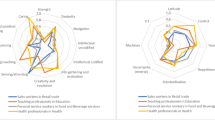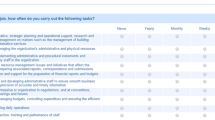Abstract
This paper contains an overview of conceptual and measurement issues related to the vertical differentiation of work tasks. The main conclusions — based on a synthetic literature review and measurement examples from the Swedish Level of Living Survey (LNU) and the European Social Survey (ESS) — are as follows. First, job complexity is the main dimension of the vertical variation in work content. A large number of empirical studies in several disciplines converge on this conclusion. Productivity appears to be the driving mechanism of the tight link between job complexity and rewards. Second, time-based measures of job complexity (skill requirements) work well. By now there are well-established indicators of educational requirements and initial on-the-job learning, with good measurement properties. However, more work is needed on indicators of continuing on-the-job learning (both formal and informal). Finally, horizontal — as opposed to vertical — variation in work content is well captured by the distinction between working with people, data and things (PDT). Broad task indicators of PDT are now included in the LNU and ESS surveys. Relations between vertical (job complexity) and horizontal (task variation within complexity levels) dimensions of work content are important issues to be examined in future research based on these and other data.
Similar content being viewed by others
Explore related subjects
Discover the latest articles, news and stories from top researchers in related subjects.References
Arvey, R. D. & Murphy, K. R. (1998). Performance evaluation in work settings. Annual Review of Psychology, 49: 141–68
Becker, G. (1962). Investment in human capital: A theoretical analysis. Journal of Political Economy, 70: S9–49
Becker, G. (1964). Human capital. New York: Columbia University Press
Bommer, W. H.; Johnson, J. L.; Rich, G. A. et al. (1995). On the interchangeability of objective and subjective measures of employee performance: A meta-analysis. Personnel Psychology, 48: 587–605
Brannick, M. T. & Levine, E. L. (2002). Job analysis. Methods, research, and applications for human resource management in the new millennium. London: Sage
Cain, P. & Treiman, D. J. (1981). The dictionary of occupational titles as a source of occupational data. American Sociological Review, 46: 253–78
Duncan, G. J. & Hoffman, S. D. (1981). The incidence and wage effects of overeducation. Economics of Education Review, 1: 75–86
Duncan, O. D. (1961). A socio-economic index for all occupations. In: A. J. Reiss Jr. (ed.): Occupations and social status. New York: Free Press
England, P. & Dunn, D. (1988). Evaluating work and comparable worth. Annual Review of Sociology, 14: 227–48
Farkas, G. (2003). Cognitive skills and non-cognitive traits and behaviors in stratification processes. Annual Review of Sociology, 29: 541–62
Fine, S. A. & Cronshaw, S. F. (1999). Functional job analysis. A foundation for human resources management. Mahwah NJ: Erlbaum
Ganzeboom, H. B. G.; De Graaf, P. M. & Treiman, D. J. (1992). A standard international socio-economic index of occupational status. Social Science Research, 21: 1–56
Gottfredson, L. S. (1986). Occupational aptitude patterns map: Development and implications for a theory of job aptitude requirements. Journal of Vocational Behavior, 29: 254–91
Handel, M. J. (2003). Skills mismatch in the labor market. Annual Review of Sociology, 29: 135–65
Hanushek, E. A. & Woessmann, L. (2008). The role of cognitive skills in economic development. Journal of Economic Literature, 46: 607–68
Harmon, C.; Oosterbeek, H. & Walker, I. (2003). The returns to education: Microeconomics. Journal of Economic Surveys, 17: 115–56
Hauser, R. M., Warren, J. R. (1997). Socioeconomic indexes for occupations: A review, update, and critique. In: A. E. Raftery (ed.): Sociological methodology, vol. 27. Cambridge MA.: Blackwell
Hunter, J. E. & Hunter, R. F. (1984). Validity and utility of alternative predictors of job performance. Psychological Bulletin, 96: 72–98
Hunter, J. E.; Schmidt, F. L. & Jackson, G. B. (2006). Implications of direct and indirect range restriction for meta-analysis methods and findings. Journal of Applied Psychology, 91: 594–612
Jeanneret, P. R.; Borman, W. C.; Kubisiak, U.C. et al. (1999). Generalized work activities. In: N. G. Peterson, M. C. Mumford, W. C. Borman et al. (eds.): An occupational information system for the 21st century: The development of the O*NET. Washington DC: APA Books
Kohn, M. & Schooler, C. (1983). Work and personality: An enquiry into the impact of social stratification. Norwood NJ: Ablex
Korpi, T. & Tåhlin, M. (2009a). Educational mismatch, wages, and wage growth: Overeducation in Sweden, 1974–2000. Labour Economics, 16: 183–93
Korpi, T. & Tåhlin, M. (2009b). A tale of two distinctions: The significance of job requirements and informal workplace training for the training gap. Working paper, Swedish Institute for Social Research (SOFI), Stockholm University
Landy, F. J. & Conte, J. M. (2010). Work in the 21st century. An introduction to industrial and organizational psychology. 3rd edition. New York: Wiley
le Grand, C. & Tåhlin, M. (2010). Class, occupation, wages and skills: The iron law of labor market inequality. Working paper, Swedish Institute for Social Research (SOFI), Stockholm University
McCormick, E. J. (1979). Job analysis: Methods and applications. New York: Amacom
Mincer, J. (1974). Schooling, experience and earnings. New York: Columbia University Press
Morgeson, F. P. & Dierdorff, E. C. (2011). Work analysis: From technique to theory. In: S. Zedeck (ed.) APA Handbook of industrial and organizational psychology, vol. 2. Washington DC: American Psychological Association
Nathan, B. R. & Alexander, R. A. (1988). A comparison of criteria for test validation: A meta-analytic investigation. Personnel Psychology, 41: 517–35
Ree, M. J.; Earles, J. A. & Teachout, M. S. (1994). Predicting job performance: Not much more than g. Journal of Applied Psychology, 79: 518–24
Rubb, S. (2003). Overeducation in the labor market: A comment and re-analysis of a meta-analysis. Economics of Education Review, 22: 621–629
Salgado, J.; Anderson, N. & Moscoso, S. et al. (2003). International validity generalization of GMA and cognitive abilities: A European community meta-analysis. Personnel Psychology, 56: 573–605
Schmidt, F. L. & Hunter, J. E. (2004). General mental ability in the world of work: Occupational attainment and job performance. Journal of Personality and Social Psychology, 86: 162–73
Schooler, C. (1984). Psychological effects of complex environments during the life span: A review and theory. Intelligence, 8: 259–81
Schooler, C.; Mulatu, M. S. & Oates, G. (2004). Occupational self-direction, intellectual functioning, and self-directed orientation in older workers: Findings and implications for individuals and societies. American Journal of Sociology, 110: 161–97
SOFI (2010). Swedish level of living surveys (LNU). Stockholm: University of Stockholm, Swedish Institute for Social Research (SOFI) — LNU web page: www.sofi.su.se/pub/jsp/polopoly.jsp?d=9324&a=35617
Spence, M. (1973). Job market signaling. Quarterly Journal of Economics, 87: 355–74
Spenner, K. (1988). Personality, work, and social stratification. Annual Review of Sociology, 14: 69–97
Stevens, G. & Featherman, D. L. (1981). A revised socioeconomic index of occupational status. Social Science Research, 10: 364–393
Tåhlin, M. (2007a). Class clues. European Sociological Review, 23: 557–72
Tåhlin, M. (2007b). Skills and wages in European labour markets: Structure and change. In: D. Gallie (ed.): Employment Regimes and the quality of work. Oxford: Oxford University Press
Treiman, D. J. (1977). Occupational prestige in comparative perspective. New York: Academic Press
Van Iddekinge, C. H. & Ployhart, R. E. (2008). Developments in the criterion-related validation of selection procedures: A critical review and recommendations for practice. Personnel Psychology, 61: 871–925
Visweswaran, C.; Ones, D. S. & Schmidt, F. L. (1996). Comparative analysis of the reliability of job performance ratings. Journal of Applied Psychology, 81: 557–74
Visweswaran, C.; Schmidt, F. L. & Ones, D. S. (2005). Is there a general factor in ratings of job performance? A meta-analytic framework for disentangling substantive and error influences. Journal of Applied Psychology, 90: 108–31
Author information
Authors and Affiliations
Corresponding author
Additional information
Acknowledgements: An early version of this paper was presented at the T.A.S.K.S workshop, Institute for Employment Research (IAB), Nuremberg, 17–18 May 2010. Thanks to the workshop participants, in particular Francis Green, Michael Handel and Daniela Rohrbach-Schmidt, as well as to Carl le Grand, Martin Hällsten, Tomas Korpi, Ryszard Szulkin, Donald Tomaskovic-Devey and two anonymous reviewers for helpful comments.
Rights and permissions
About this article
Cite this article
Tåhlin, M. Vertical differentiation of work tasks: conceptual and measurement issues. Empirical Res Voc Ed Train 3, 55–70 (2011). https://doi.org/10.1007/BF03546498
Published:
Issue Date:
DOI: https://doi.org/10.1007/BF03546498




